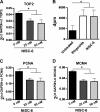Leishmanicidal Activity of Isoselenocyanate Derivatives
- PMID: 30478164
- PMCID: PMC6355615
- DOI: 10.1128/AAC.00904-18
Leishmanicidal Activity of Isoselenocyanate Derivatives
Abstract
Conventional chemotherapy against leishmaniasis includes agents exhibiting considerable toxicity. In addition, reports of drug resistance are not uncommon. Thus, safe and effective therapies are urgently needed. Isoselenocyanate compounds have recently been identified with potential antitumor activity. It is well known that some antitumor agents demonstrate effects against Leishmania In this study, the in vitro leishmanicidal activities of several organo-selenium and organo-sulfur compounds were tested against Leishmania major and Leishmania amazonensis parasites, using promastigotes and intracellular amastigote forms. The cytotoxicity of these agents was measured in murine peritoneal macrophages and their selectivity indexes were calculated. One of the tested compounds, the isoselenocyanate derivative NISC-6, showed selectivity indexes 2- and 10-fold higher than those of the reference drug amphotericin B when evaluated in L. amazonensis and L. major, respectively. The American strain (L. amazonensis) was less sensitive to NISC-6 than L. major, showing a trend similar to that observed previously for amphotericin B. In addition, we also observed that NISC-6 significantly reduced the number of amastigotes per infected macrophage. On the other hand, we showed that NISC-6 decreases expression levels of Leishmania genes involved in the cell cycle, such as topoisomerase-2 (TOP-2), PCNA, and MCM4, therefore contributing to its leishmanicidal activity. The effect of this compound on cell cycle progression was confirmed by flow cytometry. We observed a significant increase of cells in the G1 phase and a dramatic reduction of cells in the S phase compared to untreated cells. Altogether, our data suggest that the isoselenocyanate NISC-6 may be a promising candidate for new drug development against leishmaniasis.
Keywords: Leishmania; MCM4; PCNA; isoselenocyanate; topoisomerases.
Copyright © 2019 American Society for Microbiology.
Figures





References
-
- Prada CF, Álvarez-Velilla R, Balaña-Fouce R, Prieto C, Calvo-Álvarez E, Escudero-Martínez JM, Requena JM, Ordóñez C, Desideri A, Pérez-Pertejo Y, Reguera RM. 2013. Gimatecan and other camptothecin derivatives poison Leishmania DNA-topoisomerase IB leading to a strong leishmanicidal effect. Biochem Pharmacol 85:1433–1440. doi:10.1016/j.bcp.2013.02.024. - DOI - PubMed
-
- Balaña-Fouce R, Prada CF, Requena JM, Cushman M, Pommier Y, Álvarez-Velilla R, Escudero-Martínez JM, Calvo-Álvarez E, Pérez-Pertejo Y, Reguera RM. 2012. Indotecan (LMP400) and AM13-55: Two novel indenoisoquinolines show potential for treating visceral leishmaniasis. Antimicrob Agents Chemother 56:5264–5270. doi:10.1128/AAC.00499-12. - DOI - PMC - PubMed
Publication types
MeSH terms
Substances
LinkOut - more resources
Full Text Sources
Miscellaneous

